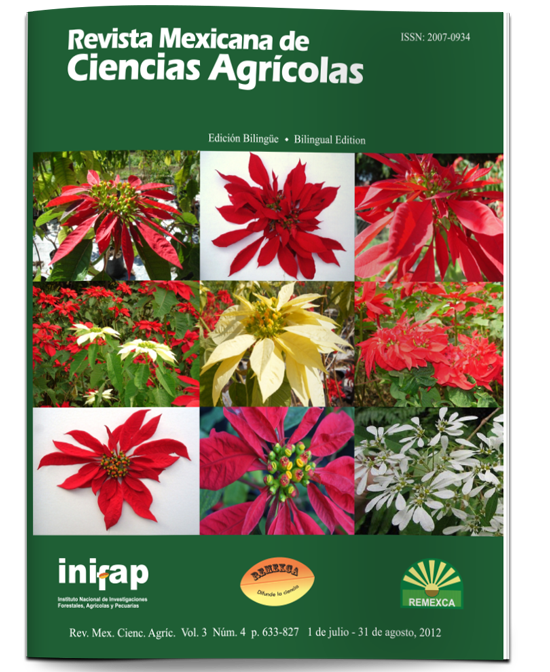Optimum cutting time for yield and quality of forage oats varieties
DOI:
https://doi.org/10.29312/remexca.v3i4.1430Keywords:
Avena sativa L., forage quality, phenological stagesAbstract
Oats cultivation is an important alternative in the region of the Highlands, because of its forage and grain production, requiring agronomic studies to optimize its management. In this study the objectives were to determine the optimal cutting time for obtaining more and better forage, and compare varieties in terms of forage yield. Twenty-four genotypes were evaluated (18 advanced lines of the oats breeding program of INIFAP and 6 commercial varieties) in eight rainfed environments of the high valleys of the States of Hidalgo, Tlaxcala, Mexico City and Mexico State in the spring- summer, 2007 and 2008, using an experimental design of randomized complete block with three replicates at each location. There were six samplings in the stages of booting, half emerged inf lorescence, anthesis, milk development and dough development. The variables measured were plant height in cm, total green area in kg ha-1, total dry matter in kg ha-1, protein percentage, calculated by the method of Larry and Charles, protein per hectare and dry matter accumulation kg ha-1 day-1. A combined analysis of variance was made and, Tukey test was applied at 5% for comparison of means. Highly significant differences were found in all the variables for the factors changing of locations, sampling and varieties as well as for the interactions localities by samplings and localities by varieties. Cutting stages with the highest forage quantity were the milky and dough development stages, harvesting up to 19 t ha-1 of dry matter and, for quality, the best one was the booting stage, recording up to 24% protein. The best forage yield was obtained in Juchitepec in 2007, while Saia variety had the highest percentage of protein. Some lines exceeded the control varieties in quantity and quality of forage produced, indicating that there is potential to implement future selection schemes and, eventually for offering options to the farmers for greater quantity and quality of forage.
Downloads
Downloads
Published
How to Cite
Issue
Section
License
The authors who publish in Revista Mexicana de Ciencias Agrícolas accept the following conditions:
In accordance with copyright laws, Revista Mexicana de Ciencias Agrícolas recognizes and respects the authors’ moral right and ownership of property rights which will be transferred to the journal for dissemination in open access. Invariably, all the authors have to sign a letter of transfer of property rights and of originality of the article to Instituto Nacional de Investigaciones Forestales, Agrícolas y Pecuarias (INIFAP) [National Institute of Forestry, Agricultural and Livestock Research]. The author(s) must pay a fee for the reception of articles before proceeding to editorial review.
All the texts published by Revista Mexicana de Ciencias Agrícolas —with no exception— are distributed under a Creative Commons License Attribution-NonCommercial 4.0 International (CC BY-NC 4.0), which allows third parties to use the publication as long as the work’s authorship and its first publication in this journal are mentioned.
The author(s) can enter into independent and additional contractual agreements for the nonexclusive distribution of the version of the article published in Revista Mexicana de Ciencias Agrícolas (for example include it into an institutional repository or publish it in a book) as long as it is clearly and explicitly indicated that the work was published for the first time in Revista Mexicana de Ciencias Agrícolas.
For all the above, the authors shall send the Letter-transfer of Property Rights for the first publication duly filled in and signed by the author(s). This form must be sent as a PDF file to: revista_atm@yahoo.com.mx; cienciasagricola@inifap.gob.mx; remexca2017@gmail.
This work is licensed under a Creative Commons Attribution-Noncommercial 4.0 International license.



